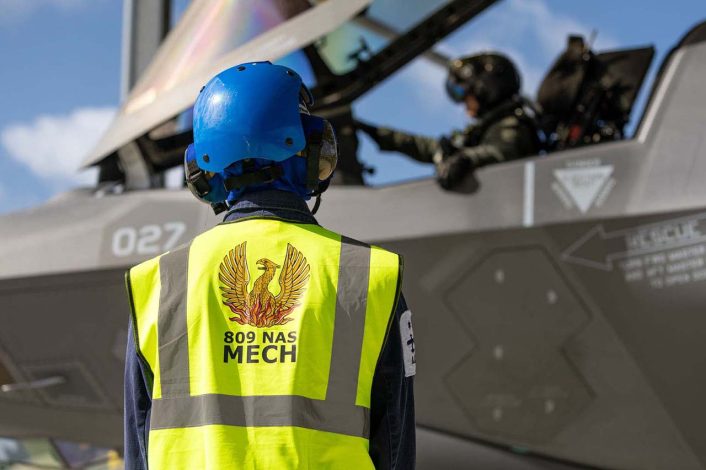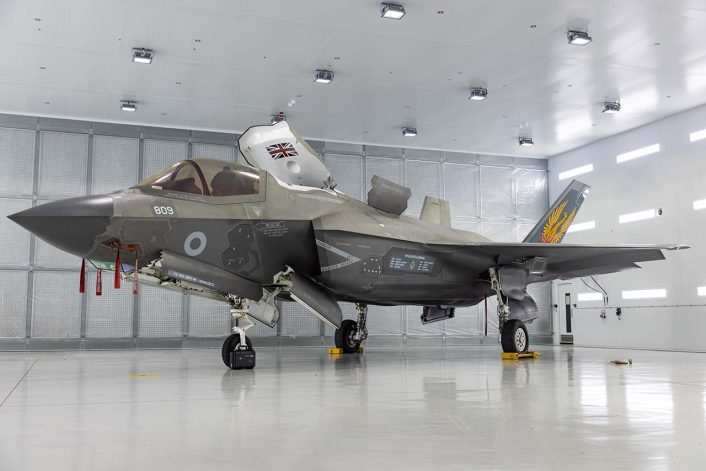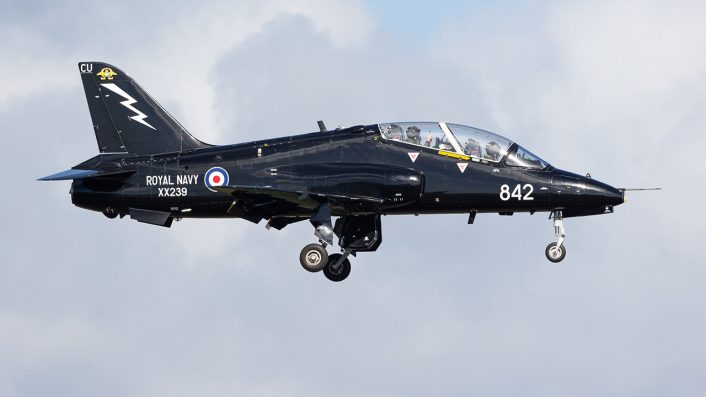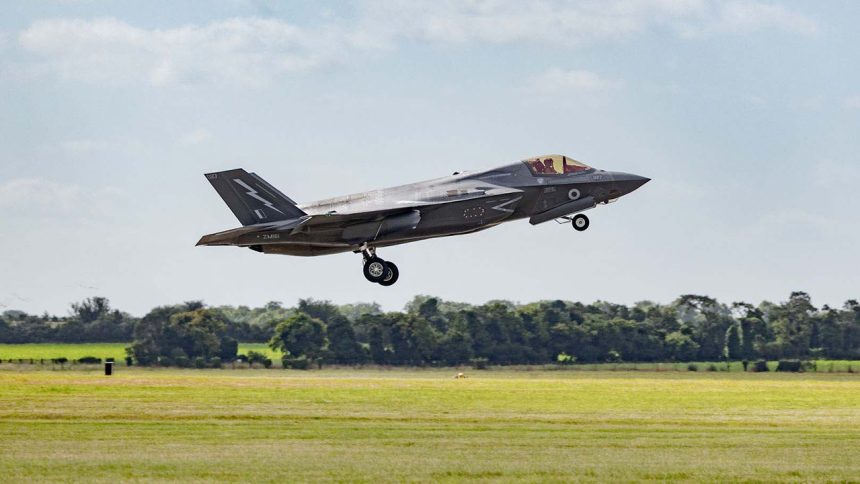After reforming in December 2023, 809 Naval Air Squadron has now flown its first ever independent sortie as the UK’s newest F-35B unit.
Joining 617 Squadron of the Royal Air Force, 809 Naval Air Squadron (NAS) is the United Kingdom’s second frontline unit operating the F-35B Lightning II multirole stealth fighter. It is the first UK F-35B squadron commissioned so far to be badged as a unit of the Royal Navy’s Fleet Air Arm, although all UK F-35B squadrons will operate with a mix of Royal Air Force and Fleet Air Arm personnel.
This flight, which took place on July 4, 2024, marked the first by 809 NAS operated solely by the squadron’s own personnel, requiring no support from the existing squadrons co-located at RAF Marham.

The Commanding Officer of 809 NAS, Commander Nick Smith, has served in the Royal Navy since 2006. After spending several years as an exchange pilot with the United States Navy flying F/A-18E Super Hornets, he became a Qualified Flying Instructor (QFI) on the F-35B in 2016. Before taking command of the new unit in December, he flew with the Royal Air Force’s 207 Squadron, which is the UK’s F-35B Operational Conversion Unit, responsible for all type specific training.
Commenting on the squadron’s first flight, he said “This was not a small ask for what is still a small, growing team and the whole squadron should feel rightfully proud of the achievement.”.
The shared approach to operating these aircraft is derived from the Joint Force Harrier concept initiated by the British military in the early 2000s, which unified the Harrier squadrons of the Royal Air Force and the Royal Navy into a single command structure. This development was the culmination of years of increasing coordination between the two forces, dating back to the 1982 Falklands War when the previously solely land-based Royal Air Force Harrier ground attack fleet was pressed into service on board the Royal Navy’s aircraft carriers, joining the air to air focused Sea Harriers. With the services now operating the F-35B, the current arrangement is frequently referred to as Joint Force Lightning.
809 NAS was chosen as the first Royal Navy F-35B squadron in 2013 by the then First Sea Lord Admiral Sir George Zambellas. The squadron was first formed during the Second World War, but arguably became most famous during the Falklands War when the unit was hastily commissioned as an additional frontline Sea Harrier FRS1 unit. Under the command of Lt Cdr Tim Gedge, airframes and aircrew were drawn from wherever possible, with some pilots even being recalled from overseas exchange programs, to train as an operational carrier-based unit in a matter of weeks. When ready, the aircraft were flown to Ascension Island and then shipped to the South Atlantic aboard the ill-fated Atlantic Conveyor. All the Harrier airframes managed to depart the converted merchant vessel before it was destroyed.
This remarkable story reinforced the squadron’s phoenix iconography, as it had metaphorically risen from the ashes. The recommissioning of 809 NAS in 2023 was the first time the squadron had been active since it decommissioned and merged with 800 and 801 Naval Air Squadrons during the 1982 war. As the last officer to command the squadron, Tim Gedge was invited to the ceremony and presented the squadron’s crest to Commander Nick Smith.
41 years on from the Falklands War, former 809 NAS boss Tim Gedge passed the baton to the new CO, Cdr Nick Smith, as the Phoenix Squadron stood up as an F-35B unit at RAF Marham this morning. An absolute pleasure and privilege to have been there to see it. BZ to all involved. pic.twitter.com/GIFs0giJws
— Rowland White (@RowlandWhite) December 8, 2023
Attention was drawn during the commissioning ceremony in Dec. 2023 when an F-35B appeared with the phoenix tail emblem often displayed proudly by the squadron. It was readily apparent that this was simply a temporary graphic applied solely for the ceremony, though many aviation enthusiasts hope it is a sign that the UK F-35B fleet may feature squadron insignia in the future. At present, the fleet is pooled between squadrons at RAF Marham and all jets carry a lightning flash tail insignia.

Interestingly, while the lightning symbol has currently been adopted for use by all UK F-35Bs, the symbol itself is the emblem of a Fleet Air Arm squadron which for a time co-existed alongside the Lightning force. From its recommissioning in 2013 to its standing down in 2022, 736 Naval Air Squadron flew several of its Hawk T1 aircraft from Royal Naval Air Station Culdrose with very similar tail markings. It had also historically been carried by the squadron’s Supermarine Scimitar aircraft. Until 809 NAS stood up in 2023, 736 NAS was the last manned jet squadron in the Fleet Air Arm.

809 NAS will continue to build flight hours and experience over the coming months as they gear up exercises on board aircraft carrier HMS Prince of Wales scheduled for this autumn. These exercises come ahead of the planned Carrier Strike Group 2025 deployment, which will see the carrier travel to the Pacific region with an expected embarked air wing of twenty four F-35Bs.
The Royal Navy and Royal Air Force will be hoping for this deployment to go smoother than many recent exercises. The Carrier Strike Group 2021 deployment notably saw an F-35B lost in the Mediterranean Sea when an intake blank, usually used to protect the aircraft’s engine and for security purposes to obscure the radar cross-section reducing geometry inside the air intakes, was left in as an F-35B attempted to take off. The blank was pulled further into the intake and blocked airflow to the engine, resulting in the aircraft not having enough power to become airborne. The jet rolled off the carrier’s distinctive ski-jump ramp and into the sea, while the pilot ejected and remarkably landed safely back on the deck.
MoD has published interim report on F-35 that crashed on launch from @HMSQNLZ on 17th November 2021 #CSG21
Confirms cause was an engine blank (cover used to prevent ingress of debris) 617 Squadron engineers failed to remove before flighthttps://t.co/E5PUsVc1K9
H/T @hthjones pic.twitter.com/tvD1CNOx8g
— Navy Lookout (@NavyLookout) September 8, 2022
While flaws in the design of the intake blank, which could make it difficult to see when in place upon quick inspection, were partly to blame, an investigation also found deficiencies in the crew’s handling and storage of aircraft blanks. Personnel lacked experience in complex deck operations, and a general shortage of crew led to those on the ship frequently facing far higher workloads than would be ideal.
The aircraft carriers themselves have also faced some technical issues, with HMS Prince of Wales recently having taken the place of HMS Queen Elizabeth in Exercise Steadfast Defender at extremely short notice due to a propulsion system issue. The Prince of Wales itself experienced propulsion issues in 2022, forcing it to cancel a deployment to the United States and go into dry dock for extensive repairs.
While the UK’s journey back to aircraft carrier operations has been far from a straight-forward one, significant progress is being made with each step as both the carriers and the aircraft begin to mature and crews become more familiar with them. Operating aircraft carriers is not an easy task, demonstrated by how few nations operate true blue-water capable carrier strike groups. Slowly, but surely, the UK is rejoining that exclusive club.









